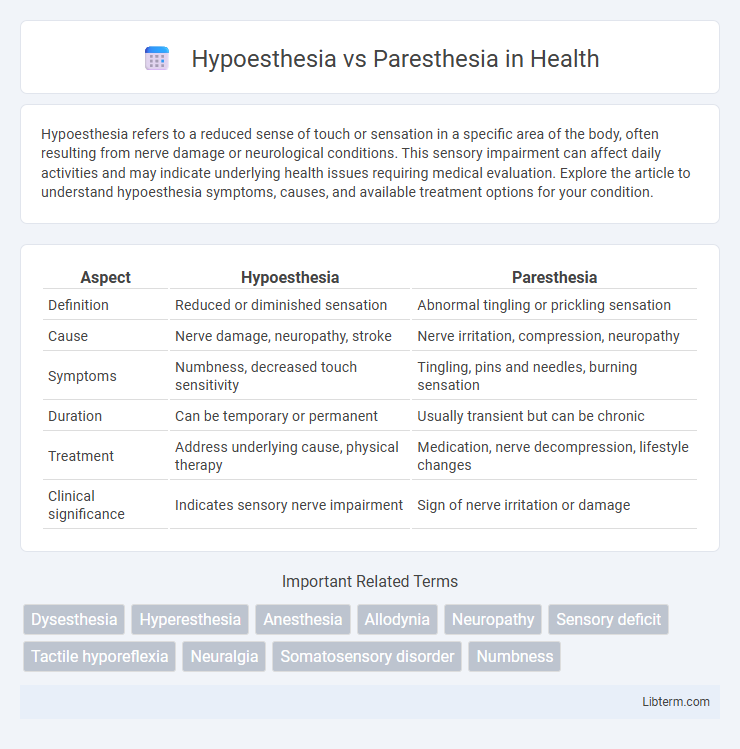Hypoesthesia refers to a reduced sense of touch or sensation in a specific area of the body, often resulting from nerve damage or neurological conditions. This sensory impairment can affect daily activities and may indicate underlying health issues requiring medical evaluation. Explore the article to understand hypoesthesia symptoms, causes, and available treatment options for your condition.
Table of Comparison
| Aspect | Hypoesthesia | Paresthesia |
|---|---|---|
| Definition | Reduced or diminished sensation | Abnormal tingling or prickling sensation |
| Cause | Nerve damage, neuropathy, stroke | Nerve irritation, compression, neuropathy |
| Symptoms | Numbness, decreased touch sensitivity | Tingling, pins and needles, burning sensation |
| Duration | Can be temporary or permanent | Usually transient but can be chronic |
| Treatment | Address underlying cause, physical therapy | Medication, nerve decompression, lifestyle changes |
| Clinical significance | Indicates sensory nerve impairment | Sign of nerve irritation or damage |
Understanding Hypoesthesia: Definition and Causes
Hypoesthesia refers to a reduced or diminished sense of touch or sensation, often caused by nerve damage, trauma, or underlying medical conditions such as diabetes, multiple sclerosis, or peripheral neuropathy. Unlike paresthesia, which involves abnormal sensations like tingling or prickling, hypoesthesia specifically denotes a loss or decrease in sensory perception. Identifying the root causes of hypoesthesia is crucial for effective diagnosis and treatment, often involving neurological assessments and imaging studies.
What is Paresthesia? Key Characteristics Explained
Paresthesia is an abnormal sensation commonly described as tingling, prickling, or numbness, often resulting from nerve irritation or damage. This sensory disturbance can be temporary or chronic and is frequently associated with conditions such as neuropathy, multiple sclerosis, or diabetic complications. Key characteristics include sensations of pins and needles, burning, or crawling, without an external stimulus causing these feelings.
Hypoesthesia vs Paresthesia: Main Differences
Hypoesthesia refers to a decreased or diminished sensitivity to sensory stimuli, often causing numbness or reduced tactile perception. Paresthesia, on the other hand, is characterized by abnormal sensations such as tingling, prickling, or a "pins and needles" feeling without an external stimulus. The main differences between hypoesthesia and paresthesia lie in hypoesthesia's loss of sensation and paresthesia's presence of unusual, often uncomfortable sensations.
Common Symptoms of Hypoesthesia
Hypoesthesia is characterized by a reduced sense of touch or sensation, often manifesting as numbness or decreased sensitivity in affected areas such as the skin or mucous membranes. Common symptoms of hypoesthesia include diminished perception of temperature, pressure, and pain, frequently observed in conditions like peripheral neuropathy or nerve compression. Unlike paresthesia, which involves abnormal sensations like tingling or prickling, hypoesthesia primarily refers to a loss or weakening of sensory input.
Typical Signs of Paresthesia
Paresthesia is characterized by abnormal sensations such as tingling, prickling, or numbness, often described as "pins and needles." These typical signs result from nerve irritation or damage affecting sensory pathways. Unlike hypoesthesia, which is a reduced sense of touch or sensation, paresthesia involves active abnormal sensory experiences without an external stimulus.
Underlying Conditions Linked to Hypoesthesia
Hypoesthesia, characterized by a reduced sense of touch or sensation, is commonly linked to underlying conditions such as peripheral neuropathy, multiple sclerosis, and stroke. Diabetic neuropathy often causes hypoesthesia by damaging peripheral nerves, leading to diminished sensory perception. Central nervous system disorders, including spinal cord injury and brain tumors, can also result in localized or widespread hypoesthetic symptoms.
Disorders Frequently Associated with Paresthesia
Paresthesia, characterized by abnormal sensations such as tingling or numbness, is frequently associated with disorders like diabetic neuropathy, multiple sclerosis, and peripheral nerve injuries. These conditions often involve nerve damage or dysfunction, leading to disrupted sensory signals and persistent paresthetic symptoms. In contrast, hypoesthesia refers to a reduced sensitivity to stimuli and is commonly linked with conditions causing nerve compression or central nervous system lesions.
Diagnostic Approaches for Sensory Disturbances
Hypoesthesia and paresthesia are diagnosed through detailed patient history and clinical examination focusing on sensory deficits and abnormal sensations. Quantitative sensory testing, nerve conduction studies, and electromyography often provide objective measurements to differentiate hypoesthesia's diminished sensation from paresthesia's abnormal tingling or burning. Imaging techniques such as MRI or ultrasound may be utilized to identify underlying causes like nerve compression or neuropathy contributing to sensory disturbances.
Treatment Options: Managing Hypoesthesia and Paresthesia
Treatment options for hypoesthesia often include addressing the underlying cause such as nerve compression or diabetes, using medications like corticosteroids or anticonvulsants to reduce inflammation and nerve pain. Managing paresthesia may involve physical therapy, vitamin supplements like B12, and lifestyle modifications to improve nerve health. In severe cases, surgical intervention or nerve decompression might be necessary to restore normal sensation and prevent further nerve damage.
Preventive Measures and Prognosis for Optimal Nerve Health
Preventive measures for hypoesthesia and paresthesia emphasize maintaining optimal nerve health through proper ergonomics, regular physical activity, and managing underlying conditions such as diabetes or vitamin deficiencies. Early diagnosis and treatment, including controlling inflammation and avoiding repetitive nerve trauma, significantly improve prognosis by reducing the risk of permanent nerve damage. Consistent monitoring and lifestyle modifications support nerve regeneration and functional recovery, ensuring long-term sensory stability.
Hypoesthesia Infographic

 libterm.com
libterm.com